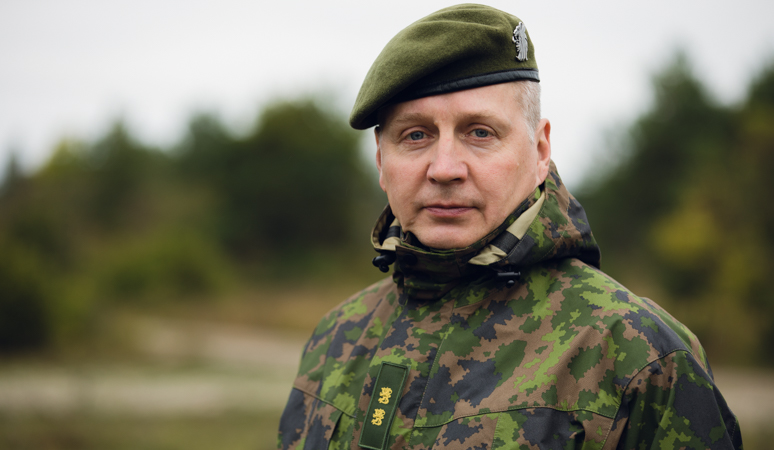100 years ago in Vaasa

Address by Commander of the Finnish Army Major General Petri Hulkko on 24 February 2018 in Vaasa in the Review of Troops as part of the 100th Anniversary of the Homecoming of the Jaegers
Honoured Veterans of our wars, Ministers of Defence, Ladies and Gentlemen, Soldiers,
Tomorrow (25.2.) marks the centenary of the main force of Finnish Jaegers returning home and standing at attention while General Mannerheim would inspect their rows. The expectations of these Jaegers must have been high indeed. Finally the moment had come for which they had initially left for Germany leaving their homes behind and heading for the unknown.
As of the year 1915, less than 2,000 Finnish young men had left from Finland to get military training in Germany. These youth were motivated by the thought of an independent Finland surfacing at some point in the future. In December 1917, the declaration of independence by Finland finally gave the Jaegers the hope of an eventual return to Finland. This return then began with the taking of a military oath in Liepaja and proceeded all the way to Vaasa. In conjunction to this return, the first unit colour of independent Finland, namely, the Jaeger Flag, was consecrated, and now in our national parades follows the Swallow-tailed State Flag.
In their versatile backgrounds, the Jaegers represented the structures, levels and layers present in society of the time. The majority of the Jaegers came from either rural or working class families. In fact, as the Jaegers represented a variety of classes, this made it easier for them to assume troop leading positions in a rural army. By the same token, it was most unfortunate that they had to fight against fellow Finns in what was a sharply divided Finland. This, for sure, must have been something that they never expected to be the case when leaving for Germany to become trained as soldiers.
Ab dem Jahr 1915 bot Deutschland weniger als zweitausend Finnischen Männern die Möglichkeit militärische Ausbildung und Kriegserfahrung zu sammeln im Verband des Königlich-Preussischen Jäger-Bataillons Nr. 27. Vor hundert Jahren kehrten die Finnischen Jäger, die eine ausgezeichnete militärische Ausbildung genossen hatten, in der Aufgabe nach Vaasa zurϋck, in die sie gegangen waren: nämlich, um das Land Finnland von fremder Macht zu befreien. Ich schätze es sehr, dass deutsche Soldaten an unserer Parade teilnehmen. Die Traditionen verbinden uns miteinander.
Following the events of 1918, the Jaegers built up the seminal officer cadre under the command of which the Defence Forces of the young republic began to be constructed and trained. As the leaders and implementers of this construction the Jaegers did excellently. This is evidenced in the contemporary independent and well-faring Finland. Over the course of the past wars from 1939 to 1945, the Jaegers manned nearly all the significant leadership positions ranging from the Finnish General Headquarters to the formations including all services. Altogether 20 Jaegers were decorated with the highest honor awarded in Finland, the Mannerheim Cross, and as many as 49 Jaegers were promoted to General. Furthermore, the majority of those who served as commanders of the Army Corps, Division or Regiment on the battlefront were Jaegers.
The Finnish Defence Forces traditions continue to draw from the legacy of the Jaegers. A number of the procedures and military practices still implemented in the Finnish Defence Forces originate from the work done by Jaegers. Similarly, the notion of general conscription well mirrors the versatility of Jaegers’ backgrounds. As such, conscription continues to retain its steady support among the Finns. In Finland, no feasible alternatives exist for replacing general conscription. An "army of all citizens" serves as the foundation of our national defence and strong support of national defence will. The deeds of the veterans of our wars in defending our fatherland set a brilliant example of the capability and will of an "army of all citizens".
Ladies and Gentlemen,
When comparing the different regions in Finland, measured in numbers, the majority of Jaegers were from Pohjanmaa. It is delightful that we are able to celebrate this centenary here in Vaasa, the capital of Pohjanmaa, to which the Jaegers’ main force returned. In February 1918, those Jaegers who were originally from Pohjanmaa literally felt that they had now come home while standing here on this winter field. I would like to thank Pohjanmaa, Ostrobothnia, and the City of Vaasa in particular, for commemorating the memory of the Jaegers and enabling the organizing of this celebration.
The significance of Jaegers in building up the Finnish Defence Forces and in safeguarding our independence during the first decades of our independence remains undeniable. We are greatly beholden to the Jaegers.
Soldiers,
Let us raise - three cheers for our fatherland!



